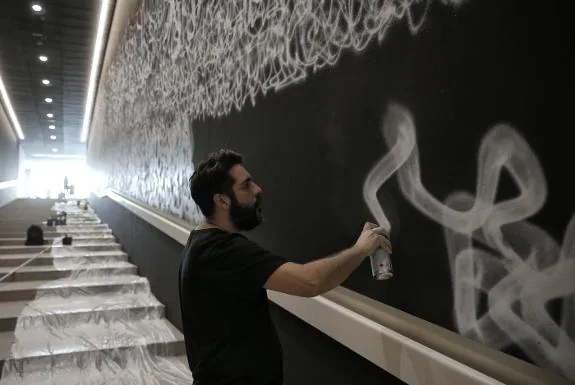Darko: light at the end of the Pompidou tunnel
The graffiti artist from Malaga shows how he has progressed with an impressive work as part of the Malaga de Festival event
Antonio Javier López
Viernes, 22 de febrero 2019, 15:38
From the wireless loudspeaker comes the thunderous voice of Zack de la Rocha spitting out the songs on his first disc with Rage Against the Machine. It sounds like the collapse of a cathedral might, a stampede of buffalos or the Hiroshima atomic bomb, which Darko would follow with a slightly vague gaze, polite but absent, his mind on other things. For example, the image in his head. It has been there for several months and, bit by bit, is being profiled on the interior staircases of the Pompidou Centre in Malaga, which are no longer their usual brilliant white but black as a wolf's mouth. This artist from Malaga is creating a colossal work of art, a physically and mentally forceful piece, a light at the end of the tunnel.
There is much more at play here than a powerful artistic event. Here, Darko reaches a new level. The self-taught creator convinced the board of the Pompidou in Paris to let him paint the walls of its Spanish branch. The wild graffiti artist has matured between the street and the museum, from rage to powerful restraint. Darko has also become the first artist to work in the Russian Museum and the Pompidou Centre in Malaga, both times as part of the Malaga de Festival (MaF) event.
These two projects now represent both sides of the same coin, because last year at the Russian Museum Darko created 'Primer movimiento' ('First movement'), a legacy of the formal restraint of the Russian avant-garde, created with black spray paint on a white background, pure geometry. Now, however, Darko has loosened the reins without getting go of them completely with this 'Segundo movimiento' of black wall and white spray, with brushes to add to the equation. The result can be seen for the next year, free of charge, at the Pompidou.
Darko's walls are each 33 metres long with a slope which starts at a height of three metres and reaches nine at the end of the staircase. "There, in the background, the wall seems to eat you up," says Darko in a voice as loud as Kurtz in 'El corazón de las tinieblas'. "Other artists have used scaffolding, but this method saved me a lot of time". He only had 24 hours in which to begin and finish his work, hence the diffusers, extensions for the brushes, the tension, the effort.
"This 'Segundo movimiento' is based on two essential aspects. One came from the recent Jean Dubuffet exhibition at the Pompidou, that traveller with no compass which the title of the exhibition talked about, and also some of the works in the montage 'Utopías modernas'. If you look at Stella or Saura, they have this type of brushstroke. And for the other, as this is a French museum, I used tachism as a base, especially Hans Hartung, a German artist who became nationalised French and fought against the Nazis".
Achieving the goal
"They put him in jail", continues Darko, "with red walls to destroy his sight. If you Google his name you will see pictures of a very elderly man, sitting in a wheelchair, painting with a fumigator like I do now. He wanted to work in large format but because he couldn't, he looked for another way to achieve his goal. I thought a great deal about that when preparing for this work..."
Darko thinks a great deal, these days. He always has, but even more so now. His life is changing, his family is growing and looking back, he can see how he has progressed. From waste ground to art galleries, trains to exhibition rooms, clandestine walls to famous museums. "It's a very big responsibility, but also something to be proud of. I'm here painting, and I'm seeing pictures by Equipo Crónica...that's amazing," he says.
So, on the left wall you can see a nebula of spray, a type of illumination, while on the right a subtle trail awaits its turn, barely a flash. "When I work, I try to look at it as an outsider, and I liked the contrast between one wall covered in paint, and the other lighter. It had to be on a black background, though, because I liked the idea of having worked the first movement in white on black and the second one the other way round, says Darko. "I had done that in run-down areas, it was already in my head".
That's why Darko doesn't mind the howling of Zack de la Rocha coming from the cylindrical loudspeaker. "I listen to them because of their energy. The first disc reminds me of my beginnings, in the street... I don't know... sorry, mate, I'm getting a bit emotional," he says. That emotion marks the rhythm of this 'Second movement'. Long may it continue.
